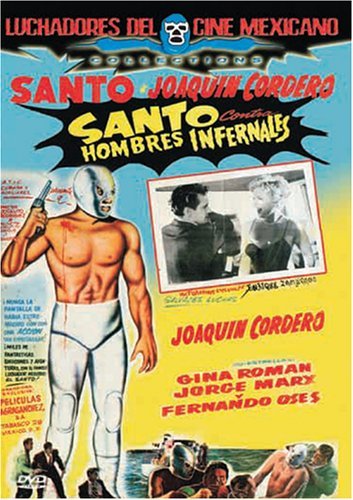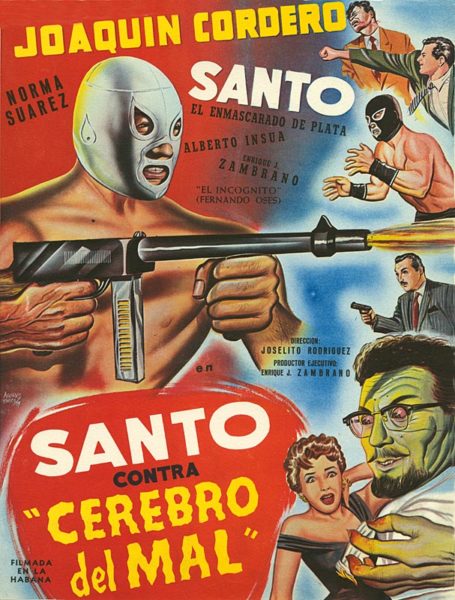On Tuesday, December 3, 2019, The Music Box Theatre in Chicago will show the first two Santo films. The films were recently restored in 4K by Permanencia Voluntaria, an archive in Tepoztlán, Mexico that is dedicated to recovering and restoring genre films from Mexico that other film restoration institutions in the country are not interested in saving. The screenings are sponsored by the Mexican Museum of Art and are co-presented by Chicago film programmer Raul Benitez with Permanencia Voluntaria founder Viviana Garcia Besne (whose grandparents produced hundreds of independent genre films in Mexico) in attendance to introduce the films and participate in a Q&A. Viviana Garcia Besne was gracious enough to chat with Daily Grindhouse about the founding of the archive, the frustrations of fundraising for such an epic endeavor, and dealing with the unexpected, potentially devastating 2017 earthquake that rocked the central part of Mexico.
Daily Grindhouse: For people who don’t know about Permanencia Voluntaria, can you give us a quick explanation of what the archive does?
Viviana Garcia Besne: Permanencia Voluntaria is a crazy project and it is the first independent Mexican archive. Our aim is to save, recover, and give dignity again to popular Mexican films. I started this project because I realized like ten years ago that Mexican film institutions who love cinema, they have a very specific criteria about what needs to be saved, where they are going to put their efforts, and their money to help preserve film history and in those current criteria, the films that I have been saving, they don’t answer to that criteria. So, I felt that someone had to do this, you know, crazy endeavor and try to save these films–and not only save the films but also try to change the appreciation that people have for them. So for that reason I am not only keeping the negatives or the masters or the best materials I’m able to save, I’m trying to put them in safe places where they are going to be understood and properly preserved. Unfortunately, that’s not happening in Mexico, that’s happening basically at the Academy Film Archive at UCLA. But I am also making a lot of research around these films: how they were made, why they were made the way they were made. And sometimes I’m rediscovering that, you know, these stories behind the films are even more fascinating than the films themselves. And this helps change our vision of what popular cinema is and it gives us a lot of respect for the audiences who love these films and also for the people who made these films.

Daily Grindhouse: Your family can be described as Mexican filmmaking royalty and you’re a documentary filmmaker yourself, did you always feel drawn to the world of movies?
Viviana Garcia Besne: Well, I mean, I never considered myself as coming from a family like the way you describe, like royalty from cinema. In a sense, I always felt a very powerful attraction towards film and for many years I had no idea why this was because my family actually was ashamed of their own legacy because at the end, the films that they were producing were the Ficheras movies and these films, this genre of Ficheras, it’s the most despised genre in Mexico, you know, like the critics and the institutions will say horrible things about these films and about the people who made these films, so in my family, no one was talking about our film legacy.
Of course, years later when I decided that I was going to do this documentary—this documentary started as a present for my grandmother. I was only going to make a short film about the stories that she told me when I was a girl and her stories were fascinating but I honestly thought that most of them were not true–like Ricardo Montalbán was going to marry her and that her father brought sound films to Mexico–all of that sounded too good to be true. But then as I started researching, I realized that yes, that I come from a family that worked a lot for a couple of generations in the film industry and they touched base everywhere from having movie theaters to having studios, laboratories, producing films.
But I think what made special my family and where I really want to honor them is that they were always thinking about the audience and they wanted to make movies for them. As movie theater owners, they would sit next to the people who would come and see their films and they would feel they were in the middle of the screening with all the people. They would feel what they wanted to see, where they were laughing, where they were crying, where they were getting bored, which actor was really important for them. And that’s how my family actually came out with a lot of formulas, as you know with the formula of the Lucha Libre, with the formula of the Ranchero, with the formula of the Rumberas, and later with the formula of the Ficheras. Because they sat among the people and they listened to them, they knew what it was that they wanted to see. That’s what made my family special and that’s where I want to follow their legacy and do justice to them and put that voice, the voice of the audience into film history because film history usually has been written by the critics. And critics, sometimes they don’t appreciate the popular taste. And I want to save, preserve, and restore a collection of films that would tell the story of their Mexican film industry, but through the eyes of the audience.
Daily Grindhouse: When you began preserving your family’s films, you’ve said you encountered quite a bit of snobbery from other Mexican film preservationists. Did that surprise you? Why do you think they had that attitude?
Viviana Garcia Besne: Yes, well as I said before, yes there’s a snobbery about what needs to be preserved and what doesn’t. I think that comes from a very deep want that the Mexican film industry has that happened during the ’70s when, you know, in a way, art cinema and popular cinema, they just clashed; they really—they just decided that they could not live at the same time and then it was rather one or the other. So it was like a battle. It was, you know, people making popular cinema, they hated independent directors that wanted to do artistic films and vice versa. That wound was also sparked by the president Luis Echeverría who told the old movie producers to get the hell out of the Mexican film industry and that now the government was going to produce films and that they were only going to produce good films. I think that that scar—that wound–is still very open today when we don’t understand that we can actually do good films that can also be popular and we are always…well, I say “we” because I feel like I am in the middle of people—I have friends who are film directors and between them, you know, they criticize each other.
I think it is very important for us to understand that there is an audience for everything and it the audience that we need to respect. When we understand that, we will also understand that Mexico is a very classist country and bringing that classism to the movie theaters is the worst that we can do. We need to find places where we can get together and have communal experiences. And that’s the movie theater, so we need to stop criticizing each other and just enjoy films and realize that cinema is not only one experience; cinema is a lot of different experiences. I mean I can have a moment of bliss, of course, watching an artistic film and I also can entertain myself and have a very nice time watching a popular film.
Daily Grindhouse: At what point did you realize the sheer enormity of the number of Mexican genre films that were in danger of being lost forever? How did that change the way you approached the mission of the archive?
Viviana Garcia Besne: After the 2017 earthquake, we realized that our archive was very, very fragile. I couldn’t just keep storing films, I had to move very quickly into restoration. Thank God the two Santo films that we’re going to see had just left my archive to go permanently to the Academy Film Archive, because if they had been there at the Archive (Permanencia Voluntaria), maybe they would have been lost forever because they are–the place where they were, it’s the place where we really lost a lot of materials.
Yes, I mean, I honestly never thought that I was going to be able to fundraise enough money to start restoring films and I am surprised by the generosity of the people and all the people that actually want to see these films survive. I am thankful that I have been able to start restoring films. I have already restored six films with the help of different institutions in the United States and also have the generosity of individuals and other smaller institutions. I have a goal of restoring at least thirty films in the next ten years that will answer to a different Mexican film history.
Nicolas Winding Refn got involved a couple of weeks before the earthquake, after I looked without any luck for funds in Mexico to restore the first two Santo films–through a common friend that is Peter Conheim from Cinema Preservation Alliance which is like my right hand—I do most of my restorations with him. He’s friends with Nicolas and he pitched the project to Nicolas and [he] came on board. And that’s how we finally found the funds, also with the help of the Academy Film Archive to restore these incredible two Santo films that our history documents because they not only mark the debut of Santo, the super-Mexican hero on the big screen, but they also mark the last films shot in Cuba just before their revolution–before Fidel Castro took over Havana and they have a very interesting story behind their shooting.

Daily Grindhouse: The screening at the Music box is a double feature of 4K restorations of SANTO EL CEREBRO DEL MAL (SANTO VS. THE EVIL BRAIN) and SANTO CONTRA HOMBRES INFERNALES (SANTO AGAINST THE HELLISH MEN). Are these the first two films you have completed restoration on?
Viviana Garcia Besne: I am super thankful to Raul Benitez, who put together this incredible program. I cannot wait; this is the first time that we were going to see the two films together. This is a fantastic opportunity for cinephiles or archivists or just normal people that want to see an incredible exercise of how these two films were shot and where these films actually share materials because they share some sequences. It’s going to be a very interesting experience. I promise I’m going to tell stories that you won’t be able to believe and that will make you see the films with a completely different perspective. I hope you can join us and have this beautiful communal experience around film. Gracias.
You can purchase tickets to the double feature screening of the films on the Music Box Theatre website here.


No Comments